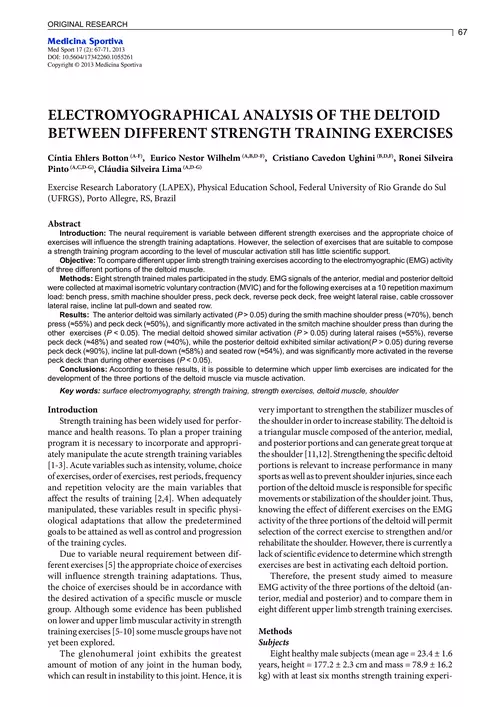
ELECTROMYOGRAPHICAL ANALYSIS OF THE DELTOID
The data show that the rear delt insulation back exercises like the reverse dream: Click the button below to take my quiz analysis to find out the best.
adsPart of the document
Introduction: The neural requirement is variable between different strength exercises and the appropriate choice of
exercises will influence the strength training adaptations. However, the selection of exercises that are suitable to compose
a strength training program according to the level of muscular activatio
n still has little scientific support.
Objective: To compare different upper limb strength training exercises according to the electromyographic (EMG) activity
of three different portions of the deltoid muscle.
Methods: Eight strength trained males participated in the study. EMG signals of the anterior, medial and posterior deltoid
were collected at maximal isometric voluntary contraction (MVIC) and for the following exercises at a 10 repetition maximum
load: bench press, smith machine shoulder press, peck deck, reverse peck deck, free weight lateral raise, cable crossover
lateral raise, incline lat pull-down and seated row. Results: The anterior deltoid was similarly activated (P
other exercises (P < 0.05). The medial deltoid showed similar activation (P
P > 0.05) during reverse
peck deck than during other exercises (P < 0.05).
Conclusions: According to these results, it is possible to determine which upper limb exercises are indicated for the
development of the three portions of the deltoid muscle via muscle activ
ation.
Key words: surface electromyography, strength training, strength exercises, deltoid muscle, shoulder
Introduction
Strength training has been widely used for perfor-
mance and health reasons. To plan a proper training
program it is necessary to incorporate and appropri-
ately manipulate the acute strength training variables
[1-3]. Acute variables such as intensity, volume, choice
of exercises, order of exercises, rest periods, frequency
and repetition velocity are the main variables that
affect the results of training [2,4]. When adequately
manipulated, these variables result in specific physi-
ological adaptations that allow the predetermined
goals to be attained as well as control and progression
of the training cycles.
Due to variable neural requirement between dif-
ferent exercises [5] the appropriate choice of exercises will influence strength training adaptations. Thus,
the choice of exercises should be in accordance with
the desired activation of a specific muscle or muscle
group. Although some evidence has been published
on lower and upper limb muscular activity in strength
training exercises [5-10] some muscle groups have not
yet been explored.
The glenohumeral joint exhibits the greatest
amount of motion of any joint in the human body,
which can result in instability to this joint. Hence, it is
very important to strengthen the stabilizer muscles of
the shoulder in order to increase stability. The deltoid is a triangular muscle composed of the anterior, medial,
and posterior portions and can generate great torque at
the shoulder [11,12]. Strengthening the specific deltoid
portions is relevant to increase performance in many
sports as well as to prevent shoulder injuries, since each
portion of the deltoid muscle is responsible for specific
movements or stabilization of the shoulder joint. Thus,
knowing the effect of different exercises on the EMG
activity of the three portions of the deltoid will permit
selection of the correct exercise to strengthen and/or
rehabilitate the shoulder. However, there is currently a lack of scientific evidence to determine which strength
exercises are best in activating each deltoid portion.
Therefore, the present study aimed to measure
EMG activity of the three portions of the deltoid (an-
terior, medial and posterior) and to compare them in
eight different upper limb strength training exercises.
Methods
Subjects
Eight healthy male subjects (mean age = 23.4 ± 1.6
years, height = 177.2 ± 2.3 cm and mass = 78.9 ± 16.2
kg) with at least six months strength training experi-


